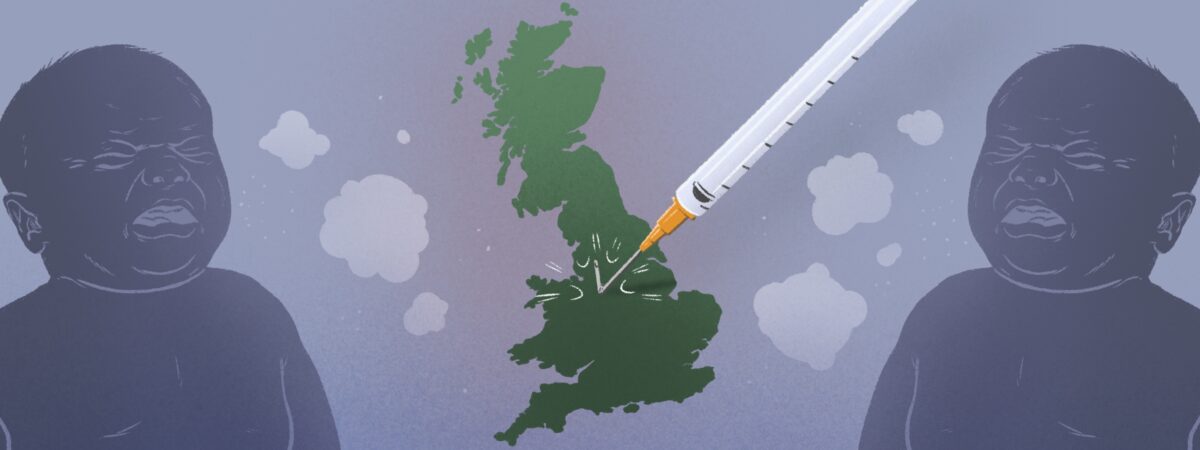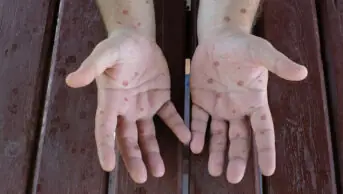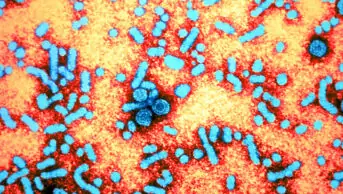Whooping cough, also known as the ‘100-day cough’ and caused by the Bordetella pertussis (B. pertussis) bacteria, is making a resurgence, after cases almost disappeared during the COVID-19 pandemic.
Suspected cases of the disease, characterised by violent coughing fits that sometimes end in a whoop-like gasp for breath, are at a 15-year high in England and Wales, according to the number of notifications from GPs collected by the UK Health Security Agency (UKHSA).
GPs in England and Wales have a statutory duty to notify their local authority of suspected cases of certain infectious diseases, including whooping cough, with these notifications then sent to the UKHSA. A diagnosis of whooping cough can be made on clinical grounds and notifications provide a timely indication of trends, but there are several diagnostic tests available that will confirm diagnoses, and laboratory-confirmed cases are also recorded by the government.
In 2023, confirmed cases in England reached 858, with more than half of those recorded in the last three months of the year. In Wales, confirmed cases rose from 5 in 2022 to 163 in 2023, while confirmed cases in Scotland rose from 3 in 2022 to 73 in 2023, 56 of which were recorded in the final quarter of the year (see Figure 1).
Whooping cough is a cyclical disease, with peaks occurring every three to four years. The reason for this is not fully understood but it is thought to result from cycling population immunity. Previous peaks in England happened in 2012, with 9,367 laboratory-confirmed cases, and 2016, with 5,949 laboratory-confirmed cases.
Measures to control the spread of COVID-19 impacted all infectious diseases, including whooping cough, and confirmed cases had been low since April 2020. However, they began to rise again in summer 2023 and, by January 2024, cases in England were still rising, with 553 laboratory-confirmed cases recorded that month.
Possible peak year
The high number of confirmed cases in late 2023 and early 2024 has sparked fears that 2024 will be another peak year for whooping cough. The number of notifications of suspected cases recorded so far in 2024 appear to support this. Between 1 January 2024 and 17 March 2024, there had been 4,294 suspected cases in England and Wales reported to the UKHSA, which compares with 946 suspected cases during the first 11 weeks of the 2016 ‘peak year’ and 524 during the first 11 weeks of 2012 (see Figure 2).
In response, on 7 March 2024, the UKHSA reminded pregnant women to get vaccinated against whooping cough to protect their babies from birth. It also encouraged parents to check that their children are vaccinated as part of the UKHSA’s new childhood immunisation campaign.
Why are cases increasing?
Whooping cough vaccination was introduced in the UK in the 1950s. Before then, more than 120,000 cases were reported each year in England and Wales.
For children, whooping cough vaccines are delivered as part of a ‘6-in-1’ combined product with vaccines against diphtheria, tetanus, polio, Haemophilus influenza type b and hepatitis B at age 8, 12 and 16 weeks. The vaccine is also delivered as part of a ‘4-in-1’ product with vaccines against diphtheria, tetanus and polio as a pre-school booster at the age of three years and four months.
Since 1992, vaccine coverage among children in England has been consistently 92% or higher by their second birthday, leading suspected whooping cough notifications to fall to fewer than 1,500 annually between 2000 and 2011. However, despite high vaccination rates at age two years of more than 95% from 2009/2010, cases of whooping cough rose and a national outbreak was declared in April 2012.
The reasons for the 2012 outbreak are unclear, but potential explanations include improved case identification, the change from whole-cell to acellular vaccines, waning immunity and genetic changes in B. pertussis.
However, in 2018/2019, vaccination rates at the age of two years fell below 95% and have continued to decrease. Data for England show that only 45 of 149 local authorities are achieving the target vaccination rate of 95% by every child’s second birthday in 2022/2023 (see Figure 3).
On average, 93% of children in England had received all three doses of the 6-in-1 vaccine by their second birthday. Hackney and City of London had the lowest rate at 71%, leaving around 3 in 10 children unprotected. Sunderland, Tyne and Wear had the highest vaccination rate at 99%.
Vaccination rates in Wales and Scotland, although falling, are still meeting the target of 95%. In Wales, on average, 95% of children had received three doses of pertussis vaccine by their second birthday in 2022/2023, with 17 of 22 local authorities achieving the 95% target. In Scotland, an average of 97% of children had received three doses of pertussis vaccine by their second birthday in the third quarter of 2022/2023, with all NHS boards achieving the 95% target.
Following a high number of cases in all age groups, but especially babies aged under three months, a temporary maternal whooping cough vaccination programme was introduced in the UK in 2012, which became part of the routine programme from 2019. The programme is aimed to protect babies who are too young to be fully vaccinated through intrauterine transfer of maternal antibodies, with women offered the vaccination from 16 weeks of pregnancy. Maternal vaccine effectiveness against death of their baby from whooping cough is 97%.
Vaccination rates for pregnant women have also been falling across England since December 2019, from an average of 74% to 58% in September 2023 (latest data available; see Figure 4). Rates are particularly low in London, where 36% of pregnant women are vaccinated. Over the past year, vaccination rates in pregnancy in Wales have also fallen, from 81% in 2021/2022 to 70% in 2022/2023 (national data are not available for Scotland).
Whooping cough hotspots
In England and Wales, most of the suspected cases recorded so far in 2024 have been in the south east of England, London and across Wales (see Figure 5).
For the week 11–17 March 2024 — the most recent week for which data are available — Nottingham recorded the highest number of suspected cases at 15 cases, followed by County Durham at 14 cases, and Bradford and Liverpool, each at 12 cases.
Age of impact
Of the laboratory-confirmed cases in England in January 2024, more than half of cases (287) were in people aged 15 years and older and 161 cases were in children aged 10–14 years.
However, incidence is highest in babies under three months of age. Babies in this age group are most at risk of developing severe whooping cough and are too young to be fully vaccinated. In January 2024, 22 of the 553 confirmed cases in England were in babies under three months of age. This compares with 48 cases in this age group during the whole of 2023 and 2 cases during 2022 (see Figure 6).
Symptoms
The incubation period for whooping cough is between one and three weeks. Symptoms usually begin like those of a cold, with a runny nose and mild cough. These symptoms develop over one to two weeks into coughing bouts that can be severe and end in a whoop-like gasp for breath and/or vomiting (see Figure 7). Coughing bouts are often worse at night, with an average of 15 attacks per 24 hours. The cough can last for 2–3 months. Symptoms are likely to be less severe and resolve more quickly if the person has been immunised or has previously had whooping cough.
Babies aged under six months may need hospital treatment owing to their increased chance of experiencing dehydration, breathing difficulties, pneumonia and seizures.
Whooping cough is transmitted easily by infected individuals through respiratory droplets. It is one of the world’s most contagious diseases, with 1 person infecting an average of 12 to 17 others. Infected individuals are contagious from 6 days after the start of cold-like symptoms to 3 weeks after the paroxysmal cough starts, or 48 hours after starting correct treatment with antibiotics (see Box).
Box: Treatment
Treatment with macrolide antibiotics is only effective if started within three weeks of the onset of the cough. After that time, the infection is no longer contagious and antibiotics are not recommended.
If the index case lives with unimmunised pregnant women or infants, or healthcare workers who work with infants and pregnant women, and has been coughing for less than three weeks, these household contacts may also be offered prophylactic antibiotics.
Symptoms can also be relieved by rest, drinking plenty of fluids and taking analgesics at the recommended doses.



